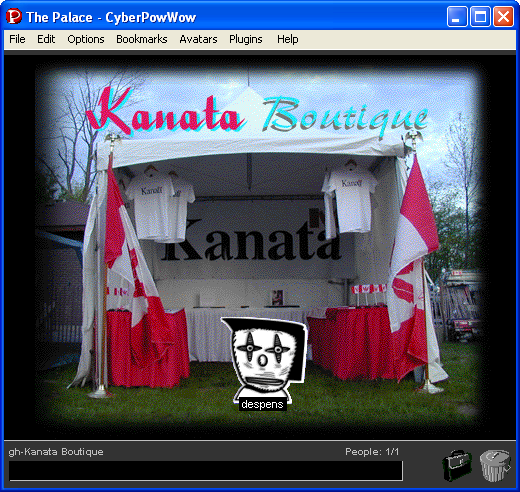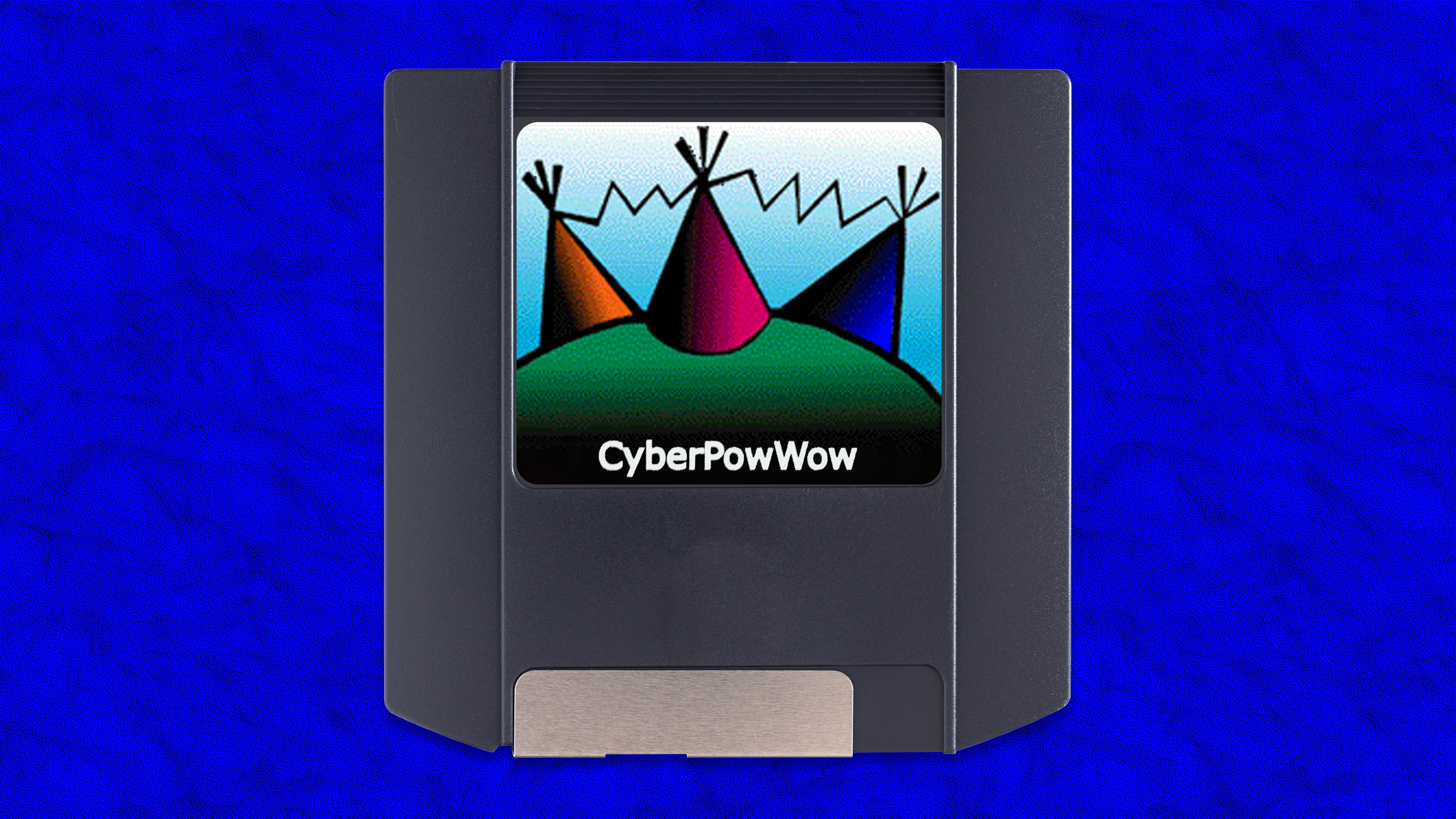Rhizome is proud to announce the first major U.S. museum presentation of CyberPowWow on December 10, 2022 at the New Museum of Contemporary Art.
First launched in 1997 by the Nation to Nation collective—Skawennati, Ryan Rice, and Eric Robertson—CyberPowWow was one of the first major online art exhibitions. Described as “an Aboriginally determined territory in cyberspace,” CyberPowWow presented works by Indigenous artists–sometimes in dialogue with works by settler artists–in a multi-user, graphical chat environment, which was available online as well as in community centers across North America. These environments will be made available online in legacy computer environments as part of a permanent exhibition space for born-digital artwork supported by Rhizome’s acclaimed digital preservation department.
Organized by Rhizome Curator Celine Wong Katzman, The one-day pop-up exhibition, panel discussion, and an upcoming online exhibition will be the first major museum presentation of CyberPowWow in the United States. This is particularly significant given the historic exclusion of Indigenous artists from cultural institutions; Rhizome’s own initial research for its Net Art Anthology even omitted CyberPowWow. To address this, Rhizome is centering the presentation of CyberPowWow as its main focus for this season’s programming. Nevertheless, this initiative is intended to build interest in CyberPowWow, opening the way for future exhibition, research, and publishing efforts about this landmark project.
“CyberPowWow is a groundbreaking platform that warrants deep critical engagement, and demonstrates the radical possibilities of self-determined communities, both online and offline. Under Rhizome’s new leadership team, we are thrilled to prioritize a continued, urgent commitment to amplifying the crucial voices of underrepresented contributors to digital culture.” —Makayla Bailey, Co-Executive Director of Rhizome
“I am thrilled to be working with Rhizome on the restoration and presentation of CyberPowWow because they really get it. Indigenous people were present at the beginning of this digital revolution that we are living and it is good that that history is being written, even better that it's happening while the artists are still around to comment.” —Skawennati
Alongside the online exhibition, a panel discussion will take place in the New Museum theater with presentations by artist Skawennati, artist Jason Lewis, and scholar Mikhel Proulx, and Rhizome’s Preservation Director Dragan Espenschied. Alongside this, four computer terminals will be made available in the Sky Room for members of the public to engage with CyberPowWow in a legacy computer environment throughout the day. Rhizome staff, including its new Co-Executive Directors Makayla Bailey and Michael Connor, will be on hand to discuss the project with members of the public.

Greg A. Hill, Buffalo Wood, Kanata Boutique, 2004. CyberPowWow 1997–2005.Palace, Windows XP. Screenshot 2022.
CyberPowWow took place in an online, graphical chat environment known as “The Palace,” with works by artists displayed in various virtual rooms, where users could also interact with one another. The online project also included networked, real-space activations—dubbed “Gathering Sites”—in which members of the public could access CyberPowWow at more than twenty artist-run centers across North America. For many visitors, this would be their first encounter with the internet or digital art.
CyberPowWow invites the user to explore virtual artist-made environments, encountering works that are often emotional and funny. The unique aesthetic and powerful affect of the exhibition mark it as an important and overlooked chapter in early net art history. The project is an engaging interactive environment that will resonate with the public, while holding specific appeal in the context of contemporary discussions about Indigeneity and sovereignty, and anticolonial positions within the museum.
This presentation of CyberPowWow is co-organized by Mikhel Proulx and Celine Wong Katzman.
The online presentation of CyberPowWow, originally scheduled to begin December 10, 2022, has been postponed to early 2023.
SKAWENNATI
Skawennati makes art that addresses history, the future, and change from her perspective as an urban Kanien’kehá:ka (Mohawk) woman and as a cyberpunk avatar. Her early adoption of cyberspace as both a location and a medium for her practice has produced groundbreaking projects such as CyberPowWow and TimeTraveller™. She is best known for her machinimas—movies made in virtual environments—but also produces still images, textiles and sculpture.
Her works have been presented in Europe, Oceania, China and across North America in exhibitions such as “Uchronia I What if?”, in the HyperPavilion at the 57th Venice Biennale; “Now? Now!” at the Biennale of the Americas; and “Looking Forward (L’Avenir)” at the Montreal Biennale. They are included in the collections of the National Gallery of Canada and the Musée d'art contemporain de Montréal, among others. She was honored to receive the 2019 Salt Spring National Art Prize Jurors’ Choice Award, a 2020 Smithsonian Artist Research Fellowship and a Visiting Artist Fellowship at the Eccles Centre for American Studies at the British Library. She is represented by ELLEPHANT.
Born in Kahnawà:ke Mohawk Territory, Skawennati belongs to the Turtle clan. She holds a BFA from Concordia University in Montreal, where she resides.
JASON LEWIS
Jason Edward Lewis is a digital media theorist, poet, and software designer. He founded Obx Laboratory for Experimental Media, where he conducts research/creation projects exploring computation as a creative and cultural material. Lewis is deeply committed to developing intriguing new forms of expression by working on conceptual, critical, creative and technical levels simultaneously. He is the University Research Chair in Computational Media and the Indigenous Future Imaginary as well as Professor of Computation Arts at Concordia University. Lewis was born and raised in northern California, and currently lives in Montreal.
Lewis directs the Initiative for Indigenous Futures, and co-directs the Indigenous Futures Research Centre, the Indigenous Protocol and AI Workshops, the Aboriginal Territories in Cyberspace research network, and the Skins Workshops on Aboriginal Storytelling and Video Game Design.
MIKHEL PROULX
Mikhel Proulx researches contemporary art and network culture. He holds a PhD from the Department of Art History at Concordia University, and has other degrees in drawing, media design and art history. He researches queer and feminist studies, participatory art, network culture, and Indigenous and settler-colonial histories of Canada.
DRAGAN ESPENSCHIED
Dragan Espenschied is the director of Rhizome’s Digital Preservation program, stewarding ArtBase, a collection 2200+ works of digital art and net art. With a background in net activism, net art, and electronic music, Espenschied has mostly focused on infrastructure and field-wide action concerning web archiving, emulation, and linked open data, rather than singular artworks.
Image: Poster for CyberPowWow, design by Laura Coombs.
PRESS CONTACT
Marcella Zimmermann
Digital Counsel, CEO
marcella@digitalcounsel.xyz


